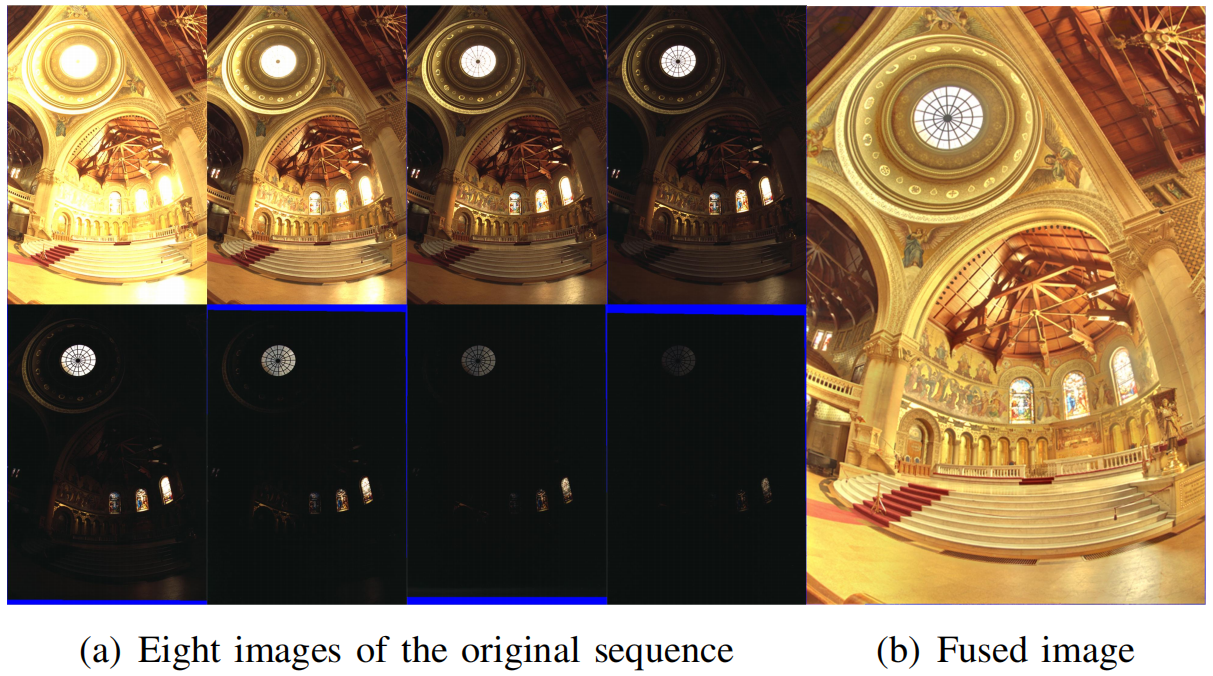Image Fusion with Guided Filtering
文章目录
- Image Fusion with Guided Filtering
-
-
- Two-scale Image Decomposition
- Weight Map Construction with Guided Filtering
- Two-scale Image Reconstruction
- Diagram of the proposed method
- Data
- Comparison with other image fusion methods
-
Two-scale Image Decomposition
给定待融合图像序列In,n=1,2,....NI_{n},n=1,2,....NIn?,n=1,2,....N,均值滤波核ZZZ,滤波核尺寸为31×3131×3131×31:
Bn=In?ZDn=In?BnB_{n}=I_{n}*Z \\D_{n}=I_{n}-B_{n} Bn?=In??ZDn?=In??Bn?
其中BnB_{n}Bn?为基础层,DnD_{n}Dn?为细节层。
Weight Map Construction with Guided Filtering
用3×33×33×3的Laplacian算子LLL从待融合图像序列中获取高频信息HnH_{n}Hn?:
Hn=In?LH_{n}=I_{n}*L Hn?=In??L
为去除噪声的影响,对此高频信息的绝对值做一个简单的低通滤波,即得到本文所定义的Saliency Map SnS_{n}Sn?:
Sn=∣Hn∣?grg,σgS_{n}=|H_{n}|*g_{r_{g},\sigma{g}} Sn?=∣Hn?∣?grg?,σg?
Saliency Map表示了图像序列中的图像所包含的细节信息的显著程度,在融合的过程中,将对细节信息更为显著的图像赋予给高的融合权重,通过比较Saliency Map 得到一个初步的融合权重:
Pnk={1if Snk=max?(S1k,S2k,…,SNk)0otherwise P_{n}^{k}=\left\{\begin{array}{cc} 1 & \text { if } S_{n}^{k}=\max \left(S_{1}^{k}, S_{2}^{k}, \ldots, S_{N}^{k}\right) \\ 0 & \text { otherwise } \end{array}\right. Pnk?={
10? if Snk?=max(S1k?,S2k?,…,SNk?) otherwise ?
当然PPP不能直接用于对待融合图像序列的融合,还需要考虑到图像当中的噪声、边缘等,需要使用Guide Filter对此融合权重进行细化,如下:
WnB=Gr1,?1(Pn,In)WnD=Gr2,?2(Pn,In)\begin{array}{l} W_{n}^{B}=G_{r_{1}, \epsilon_{1}}\left(P_{n}, I_{n}\right) \\ W_{n}^{D}=G_{r_{2}, \epsilon_{2}}\left(P_{n}, I_{n}\right) \end{array} WnB?=Gr1?,?1??(Pn?,In?)WnD?=Gr2?,?2??(Pn?,In?)?
其中r、?r、\epsilonr、?分别对应Guide Filter的滤波核半径核正则化参数,以上权重需要归一化
Two-scale Image Reconstruction
最后的图像融合的步骤,需要分别用以上计算出来的WnB、WnDW_{n}^{B}、W_{n}^{D}WnB?、WnD?对基础层和细节层进行加权,然后将融合过后的基础层和细节层加起来,得到最终的融合结果:
Bˉ=∑n=1NWnBBnDˉ=∑n=1NWnDDnF=Bˉ+Dˉ\begin{aligned} \bar{B} &=\sum_{n=1}^{N} W_{n}^{B} B_{n} \\ \bar{D} &=\sum_{n=1}^{N} W_{n}^{D} D_{n} \\ F&=\bar{B}+\bar{D} \end{aligned} BˉDˉF?=n=1∑N?WnB?Bn?=n=1∑N?WnD?Dn?=Bˉ+Dˉ?
Diagram of the proposed method
下图为本文所提算法的流程图,从流程图可以看出,本文所提算法先将图像分解为基础层和细节层,用Laplacian算法的低通结果计算权重图,最后用权重图对图像序列进行加权,得到最终的融合结果
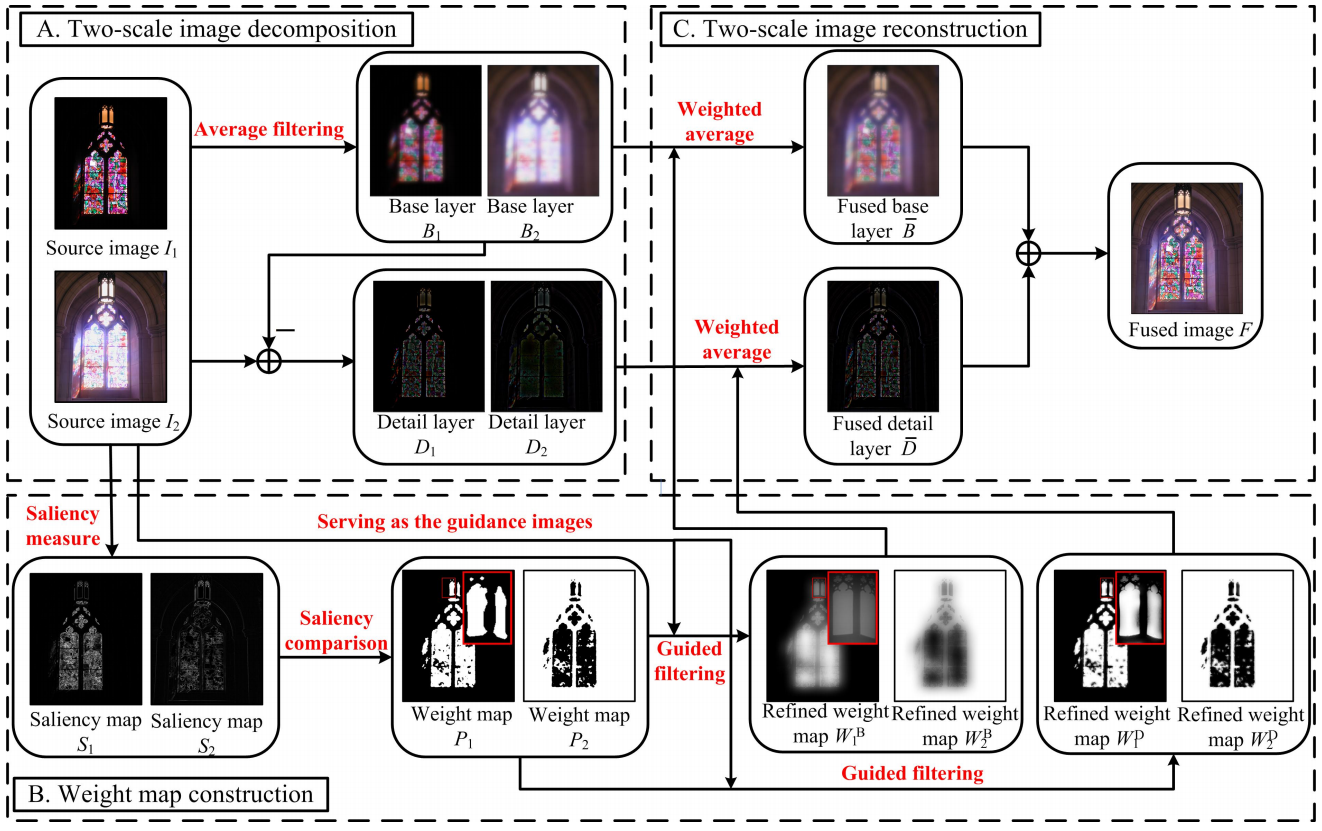
Data
本篇文章的算法验证用到了Petrovic数据库中的多光谱数据、多对焦数据、多曝光数据,均为公开数据
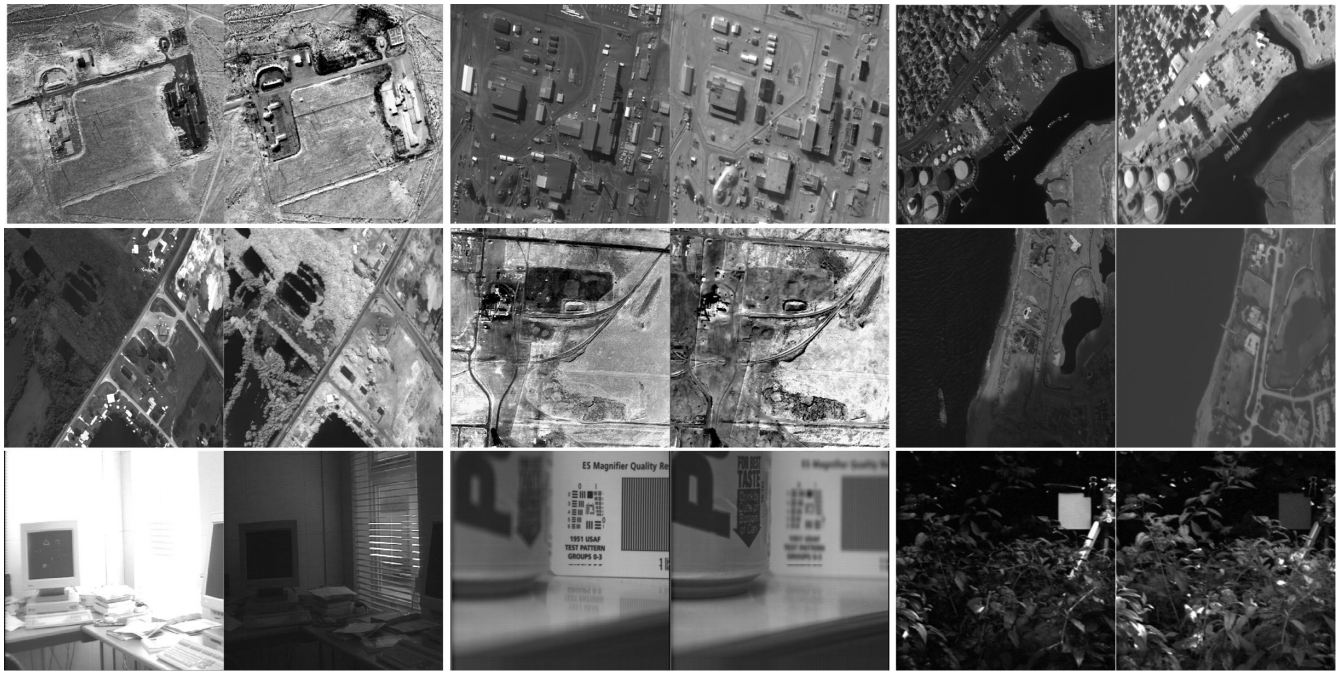
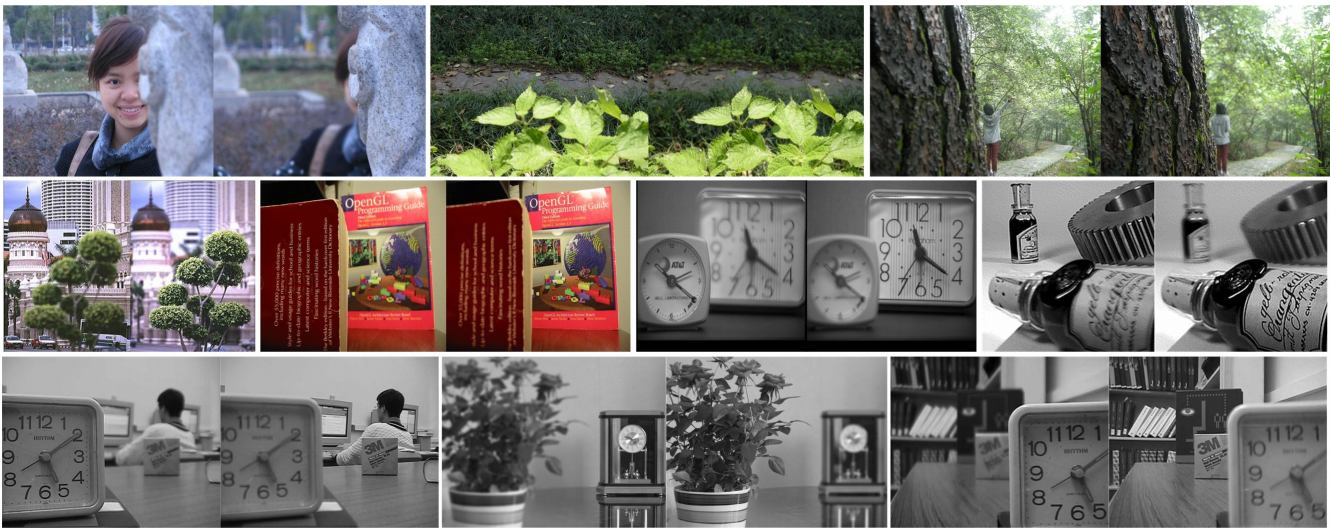

1.Normalized mutual information:用于测量待融合图像中的信息在融合结果中的保留程度
QMI=2[MI(A,F)H(A)+H(F)+MI(B,F)H(B)+H(F)]MI(A,F)=H(A)+H(F)?H(A,F)Q_{M I}=2\left[\frac{M I(A, F)}{H(A)+H(F)}+\frac{M I(B, F)}{H(B)+H(F)}\right]\\ M I(A, F)=H(A)+H(F)-H(A, F) QMI?=2[H(A)+H(F)MI(A,F)?+H(B)+H(F)MI(B,F)?]MI(A,F)=H(A)+H(F)?H(A,F)
其中HHH是计算边缘熵(Marginal Entropy),H(A,F)H(A,F)H(A,F)是计算交叉熵(Joint Entropy),MIMIMI是计算互信息(Mutual Information)
2.Yang metric:用于测量待融合图像中的结构信息在融合结果中的保留程度
QY={λwSSIM(Aw,Fw)+(1?λw)SSIM(Bw,Fw)if SSIM?(Aw,Bw∣w)≥0.75max?{SSIM?(Aw,Fw),SSIM?(Bw,Fw)}if SSIM?(Aw,Bw∣w)<0.75Q_{Y}=\left\{\begin{array}{c} \lambda_{w} S S I M\left(A_{w}, F_{w}\right)+\left(1-\lambda_{w}\right) S S I M\left(B_{w}, F_{w}\right) \\ \text { if } \operatorname{SSIM}\left(A_{w}, B_{w} \mid w\right) \geq 0.75 \\ \max \left\{\operatorname{SSIM}\left(A_{w}, F_{w}\right), \operatorname{SSIM}\left(B_{w}, F_{w}\right)\right\} \\ \text { if } \operatorname{SSIM}\left(A_{w}, B_{w} \mid w\right)<0.75 \end{array}\right. QY?=????????λw?SSIM(Aw?,Fw?)+(1?λw?)SSIM(Bw?,Fw?) if SSIM(Aw?,Bw?∣w)≥0.75max{
SSIM(Aw?,Fw?),SSIM(Bw?,Fw?)} if SSIM(Aw?,Bw?∣w)<0.75?
其中www是7×77×77×7的窗口,λw=s(Aw)s(Aw)+s(Bw)\lambda_{w}=\frac{s\left(A_{w}\right)}{s\left(A_{w}\right)+s\left(B_{w}\right)}λw?=s(Aw?)+s(Bw?)s(Aw?)?,sss是计算方差
3.Cvejic matric:用于测量待融合图像中的重要信息在融合结果中的保留程度
QC=μ(Aw,Bw,Fw)UIQI(Aw,Fw)+(1?μ(Aw,Bw,Fw))UIQI(Bw,Fw)Q_{C}=\mu\left(A_{w}, B_{w}, F_{w}\right) U I Q I\left(A_{w}, F_{w}\right)+\left(1-\mu\left(A_{w}, B_{w}, F_{w}\right)\right) U I Q I\left(B_{w}, F_{w}\right) QC?=μ(Aw?,Bw?,Fw?)UIQI(Aw?,Fw?)+(1?μ(Aw?,Bw?,Fw?))UIQI(Bw?,Fw?)
μ(Aw,Bw,Fw)={0,if σAFσAF+σBF<0σAFσAF+σBF,if 0≤σAFσAF+σBF<11,if σAFσAF+σBF>1\mu\left(A_{w}, B_{w}, F_{w}\right)=\left\{\begin{array}{cc} 0, & \text { if } \frac{\sigma_{A F}}{\sigma_{A F}+\sigma_{B F}}<0 \\ \frac{\sigma_{A F}}{\sigma_{A F}+\sigma_{B F}}, & \text { if } 0 \leq \frac{\sigma_{A F}}{\sigma_{A F}+\sigma_{B F}}<1 \\ 1, & \text { if } \frac{\sigma_{A F}}{\sigma_{A F}+\sigma_{B F}}>1 \end{array}\right. μ(Aw?,Bw?,Fw?)=????0,σAF?+σBF?σAF??,1,? if σAF?+σBF?σAF??<0 if 0≤σAF?+σBF?σAF??<1 if σAF?+σBF?σAF??>1?
其中σ\sigmaσ表示协方差,UIQIUIQIUIQI是引自《A universal image quality index》的图像质量指标
4.Gradient based index:用于测量待融合图像中的边缘信息在融合结果中的保留程度
QG=∑i=1N∑j=1M(QAF(i,j)τA(i,j)+QBF(i,j)τB(i,j))∑i=1N∑j=1M(τA(i,j)+τB(i,j))Q_{G}=\frac{\sum_{i=1}^{N} \sum_{j=1}^{M}\left(Q^{A F}(i, j) \tau^{A}(i, j)+Q^{B F}(i, j) \tau^{B}(i, j)\right)}{\sum_{i=1}^{N} \sum_{j=1}^{M}\left(\tau^{A}(i, j)+\tau^{B}(i, j)\right)} QG?=∑i=1N?∑j=1M?(τA(i,j)+τB(i,j))∑i=1N?∑j=1M?(QAF(i,j)τA(i,j)+QBF(i,j)τB(i,j))?
QAF=QgAFQoAF;QBF=QgBFQoBFQ^{A F}=Q_{g}^{A F} Q_{o}^{A F};Q^{B F}=Q_{g}^{B F} Q_{o}^{B F} QAF=QgAF?QoAF?;QBF=QgBF?QoBF?
其中QgQ_{g}Qg?表示融合结果对原图边缘强度的保留程度,QoQ_{o}Qo?表示融合结果对原图边缘方向的保留程度,τττ为设定的权重
5.Phase congruency based index:用于测量待融合图像中的显著信息在融合结果中的保留程度
QP=(Pp)α(PM)β(Pm)γQ_{P}=\left(P_{p}\right)^{\alpha}\left(P_{M}\right)^{\beta}\left(P_{m}\right)^{\gamma} QP?=(Pp?)α(PM?)β(Pm?)γ
其中p、M、mp、M、mp、M、m分别表示相位一致性、矩的最大值、矩的最小值,α、β、γ\alpha、\beta、\gammaα、β、γ一般设置为1
下图是本文所提算法在以上5个指标的具体表现,其中rrr为guide filter的滤波窗口尺寸,$\epsilon $为正则化参数
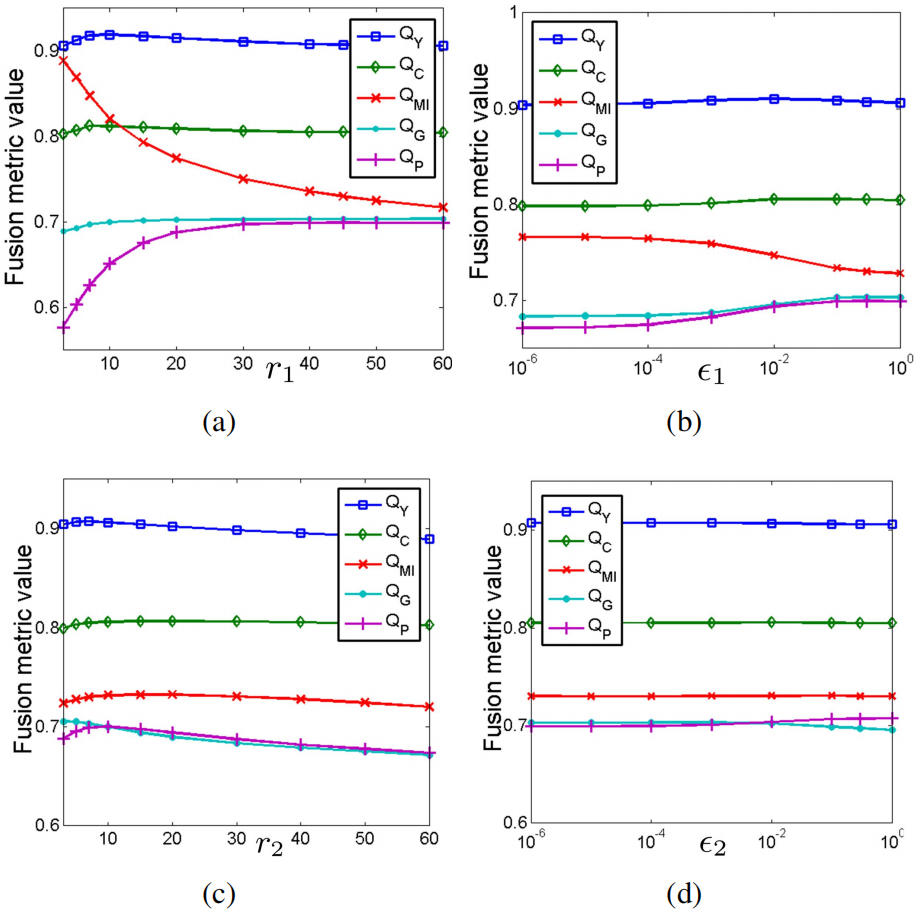
Comparison with other image fusion methods
下图分别是本文所提算法与其他算法融合灰度图像、彩色图像效果比较示意图,本文所提算法对细节保留能力较高不产生伪影,且能够在一定程度上避免产生鬼影
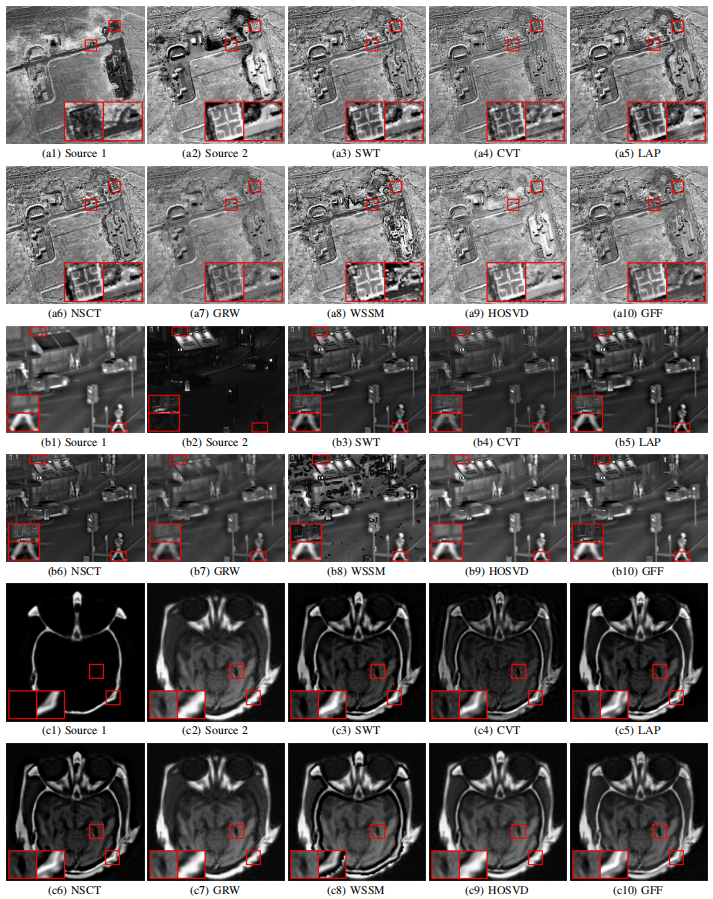
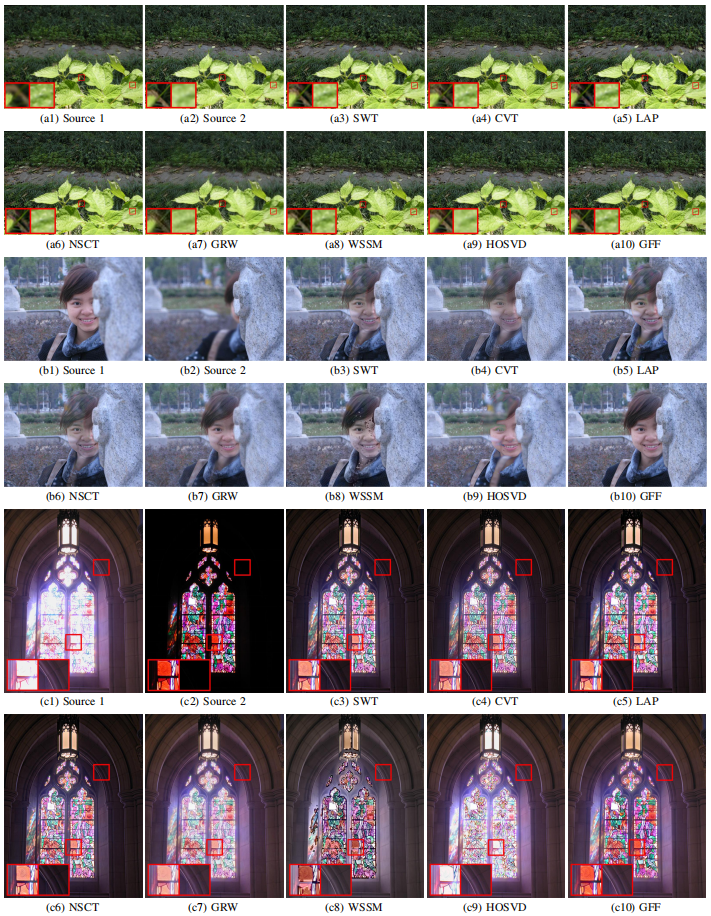
下图是本文所提算法与其他算法融合多对焦图像的效果对比示意图,本文所提算法产生的Halo相对较轻
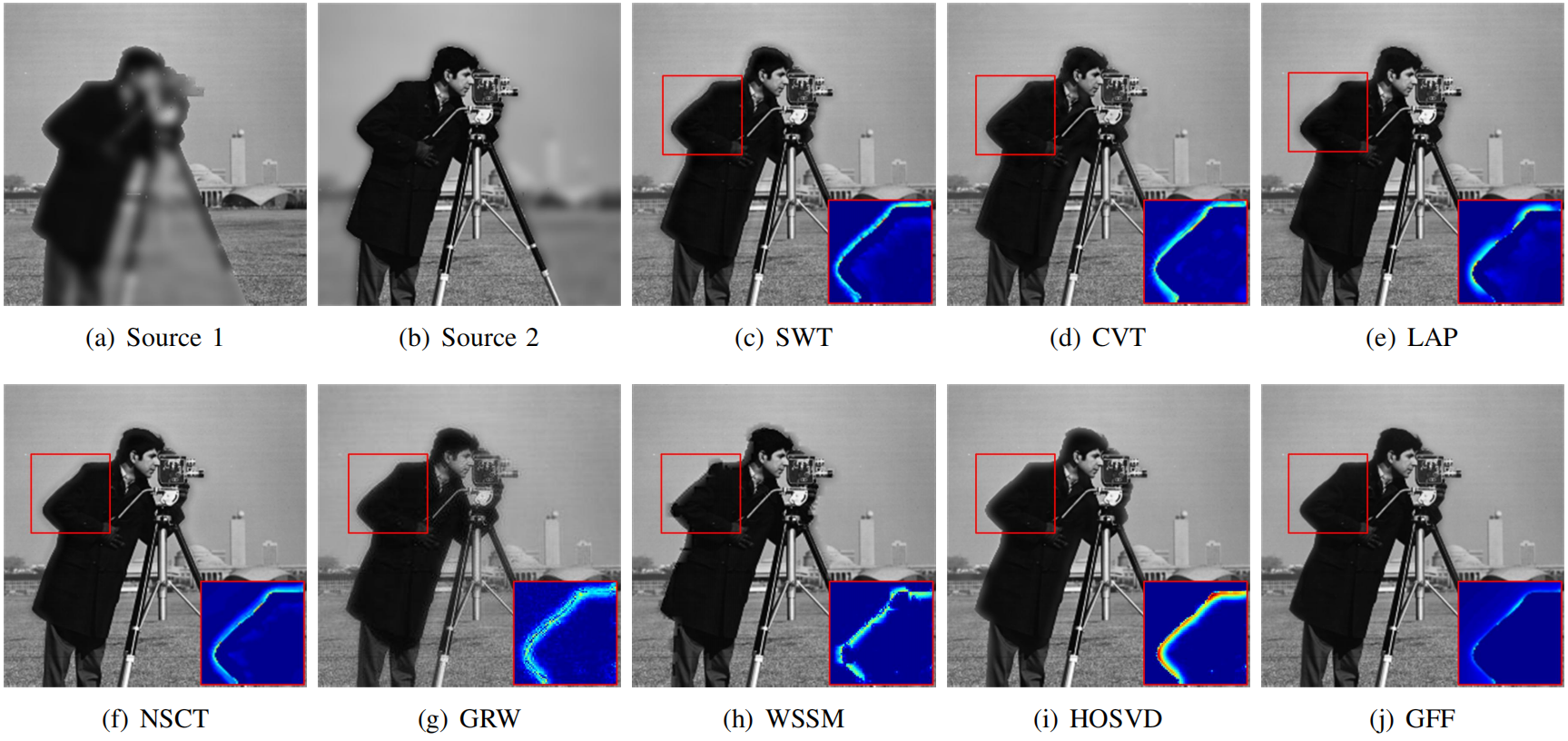
下表是以上三组图像融合结果在上述的5个客观指标与其他算法的比较,综合看来,本文所提算法在性能指标上表现较好
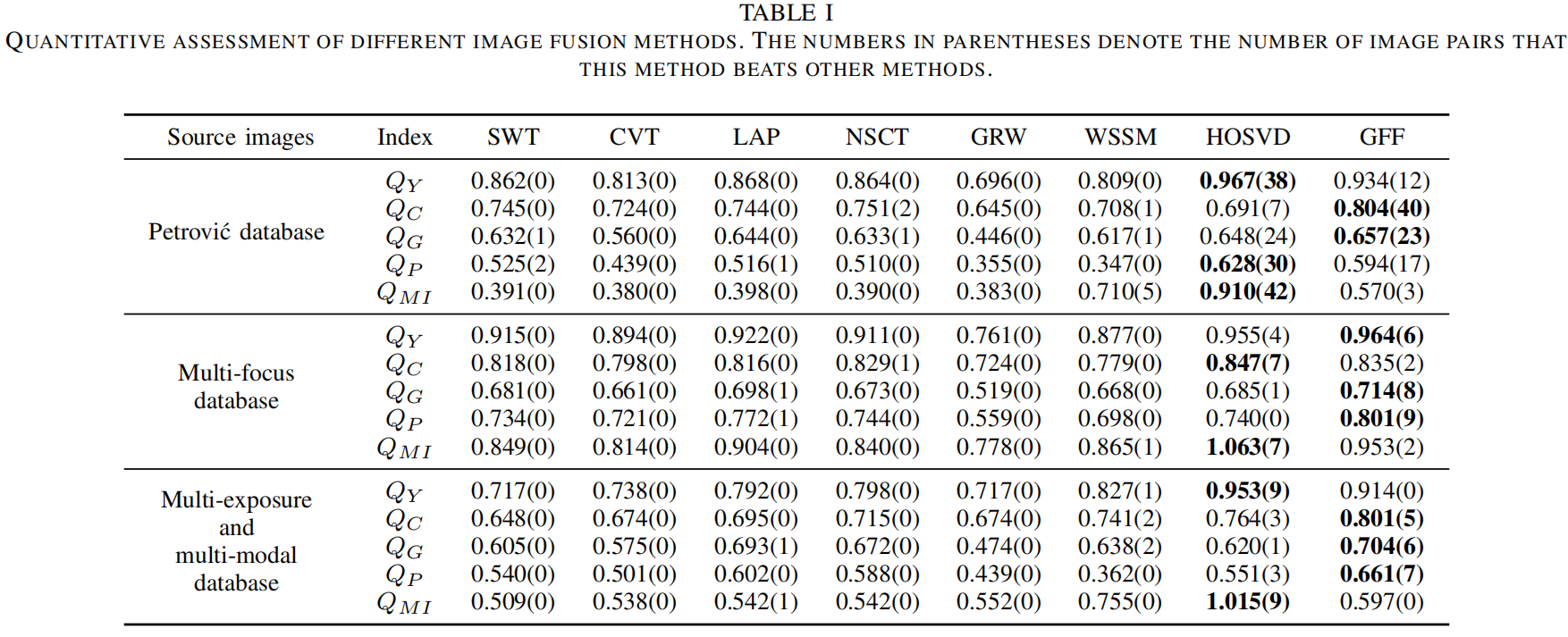
前面验证的待融合图像序列中都仅有两帧待融合图像,下图是8帧待融合数据使用本文方法的融合结果
